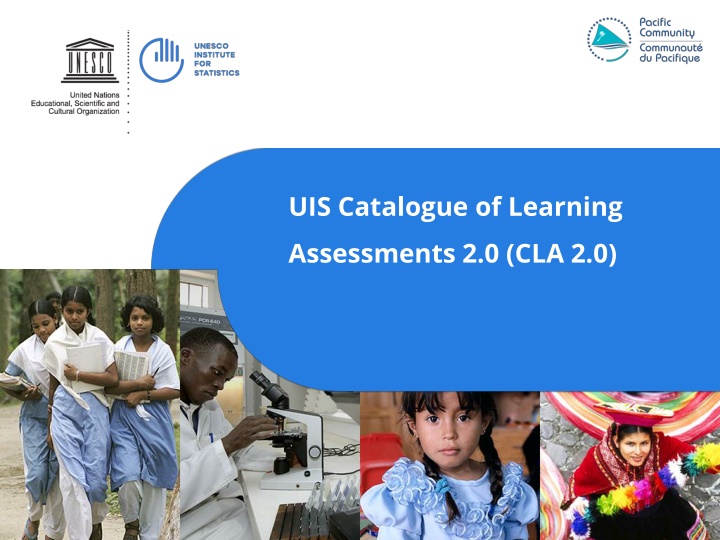
UIS Catalogue of Learning Assessments 2.0 (CLA 2.0)
Explore the Catalogue of Learning Assessments Version 2.0 (CLA 2.0) by UIS, an initiative compiling standardized information on learning outcomes assessments worldwide. Discover its purpose, scope, structure, relevance to Sustainable Development Goals, expected products, implementation time framework, target partners, and more.
Download Presentation

Please find below an Image/Link to download the presentation.
The content on the website is provided AS IS for your information and personal use only. It may not be sold, licensed, or shared on other websites without obtaining consent from the author. If you encounter any issues during the download, it is possible that the publisher has removed the file from their server.
You are allowed to download the files provided on this website for personal or commercial use, subject to the condition that they are used lawfully. All files are the property of their respective owners.
The content on the website is provided AS IS for your information and personal use only. It may not be sold, licensed, or shared on other websites without obtaining consent from the author.
E N D
Presentation Transcript
UIS Catalogue of Learning Assessments 2.0 (CLA 2.0)
OVERVIEW What is the Catalogue of Learning Assessments Version 2 (CLA 2.0)? What is the purpose of CLA 2.0? What is the scope of CLA 2.0? What is the structure of CLA 2.0? What is the relevance of CLA 2.0 to the monitoring of Sustainable Development Goal (SDG) on education? What are the expected products from the CLA project? What is the time framework of the CLA 2.0 implementation? Who are the UIS target partners for the CLA data collection? CLA 2.0
What is the Catalogue of Learning Assessments Version 2 (CLA 2.0)? The Catalogue project (or CLA) is the UIS initiative to compile standardised information on various aspects of learning outcomes (skills, or development) assessments in countries across the world. CLA 1.0 was lunched in 2014 CLA 2.0 is an enhanced version CLA 2.0
What is the purpose of CLA 2.0? Map national, regional and international learning assessments; Compare commonalities and differences with the objective of guiding international dialogue on what learning means, and how it is assessed and reported; Help countries evaluate and improve the quality and robustness of their assessment/examination systems; Help countries and donors identify capacity-development needs.
What is the scope of CLA 2.0? Type of assessments* School-based assessments (or survey) Household-based assessments (or survey) Both cross-national assessments and national assessments Areas of assessment Early childhood development Reading, mathematics, citizenship education, education for sustainable development, environmental science, and geoscience. ICT skills, functional literacy and numeracy, digital literacy Children between birth and the age at which primary schooling begins School-age children, both in school and out-of-school Youth and adults Since 2010 Target populations of assessment Year of assessments implemented Note: *Including assessments, public examinations, and surveys
What is the structure of CLA 2.0? The CLA 2.0 consists of two modules: Module 1 collects information about the characteristics of national and cross-national learning (skills, or development) assessments in countries. Module 2 collects the results of national learning (skills, or development) assessments as well as some key definitions of the national assessments on proficiency levels and the minimum proficiency level, for instance.
What is the relevance of CLA 2.0 to the monitoring of Sustainable Development Goal (SDG) on education? The data and information collected through the CLA 2.0 are relevant SDG 4 targets on learning outcomes (skills, or development). The specific associated indicators include: 4.1.1Proportion of children and young people (a) in Grade 2 or 3; (b) at the end of primary education; and (c) at the end of lower secondary education achieving at least a minimum proficiency level in (i) reading and (ii) mathematics, by sex 4.1.2 Administration of a nationally-representative learning assessment (a) in Grade 2 or 3; (b) at the end of primary education; and (c) at the end of lower secondary education 4.2.1 Proportion of children under 5 years of age who are developmentally on track in health, learning and psychosocial well-being 4.4.1 Proportion of youth and adults with information and communications technology (ICT) skills, by type of skill 4.4.2 Percentage of youth/adults who have achieved at least a minimum level of proficiency in digital literacy skills 4.5.1 Parity indices (female/male, rural/urban, bottom/top wealth quintile and others such as disability status, indigenous peoples and conflict-affected, as data become available) for all education indicators on this list that can be disaggregated 4.6.1 Proportion of population in a given age group achieved at least a fixed level of proficiency in functional (a) literacy and (b) numeracy skills, by sex CLA 2.0 4.7.4 Percentage of students by age group (or education level) showing adequate understanding of issues relating to global citizenship and sustainability
What are the expected products from the CLA project? Mapping of the characteristics of learning outcomes/skills assessments in countries worldwide; Metadata for national and cross-national learning/skills assessments; Database of national learning/skills outcomes on primary and secondary education, early childhood development, the skill levels of youth and adults, equity in education, and knowledge about global citizenship CLA 2.0
What is the time framework of the CLA 2.0 implementation? Pilot survey and refine the questionnaires October 2017- February 2018 Concept note development September 2016 Questionnaire design (Modules 1&2) January - October 2017 Data collection April - November, 2018 Data analysis and dissemination September, 2018 February, 2019 Data processing May - August/October, 2018 Other extended products of CLA 2.0 October 2018- December, 2019 CLA 2.0
Who are the UIS target partners for the CLA data collection?
Data to transform lives Name and Title Mail http://uis.unesco.org/ Learn more http://uis.unesco.org/ @UNESCOstat
